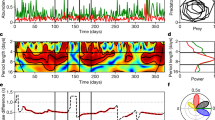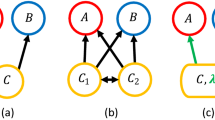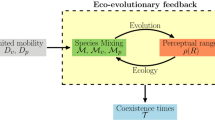Abstract
POPULATION ecology typically focuses on particular species or pairs of species within webs of interacting species to understand variations in their abundance. Classical theory1–3 predicts multi-generation cycles in predator and prey abundance. These cycles have received considerable attention3–6, although there is an alternative possibility, of prey generation-length cycles in predator–prey interactions7–9. Does observation of either of these patterns depend on how firmly predators and prey are embedded in their web of interactions? Concurrent investigations of predator–prey dynamics both in isolation and within a larger web have been lacking. Here we report observations of the population dynamics of a simple predator–prey system, and also of a three-species system including predator and prey. The dynamic patterns exhibited by both systems are cyclic, but the increase from two to three species gives rise to a marked shift in cycle peroid from one to several host generation lengths.
This is a preview of subscription content, access via your institution
Access options
Subscribe to this journal
Receive 51 print issues and online access
$199.00 per year
only $3.90 per issue
Buy this article
- Purchase on Springer Link
- Instant access to full article PDF
Prices may be subject to local taxes which are calculated during checkout
Similar content being viewed by others
References
Lotka, A. J. Elements of Physical Biology (Williams and Wilkins, New York, 1925).
Volterra, V. J. Cons. perm. Int. Explor. Mer 3, 3–51 (1928).
Begon, M., Harper, J. L. & Townsend, C. R. Ecology: Individuals, Populations and Communities 3rd edn (Blackwell Science, Oxford, 1996).
Myers, J. H. Adv. Ecol. Res. 18, 179–242 (1988).
Hanski, I., Turchin, P., Korpimaki, E. & Henttonen, H. Nature 364, 232–235 (1993).
Krebs, C. J. et al. Science 269, 1112–1115 (1995).
Godfray, H. C. J. & Hassell, M. P. J. Anim. Ecol. 58, 153–174 (1989).
Gordon, D. M., Nisbet, R. M., De Roos, A., Gurney, W. S. C. & Stewart, R. R. J. Anim. Ecol. 60, 295–308 (1991).
Briggs, C. J. & Godfray, H. C. J. Am. Nat. 145, 855–887 (1995).
Sait, S. M. et al. Ecol. Ent. 20, 199–201 (1995).
Harvey, J. A., Harvey, I. F. & Thompson, D. J. Ecology 75, 1420–1428 (1994).
Sait, S. M., Begon, M. & Thompson, D. J. J. invert. Pathol. 63, 107–110 (1994).
Turchin, P. & Taylor, A. D. Ecology 73, 289–305 (1992).
Sait, S. M., Begon, M. & Thompson, D. J. J. Anim. Ecol. 63, 541–550 (1994).
Begon, M., Sait, S. M. & Thompson, D. J. Proc. R. Soc. Lond. B 260, 131–137 (1995).
Sait, S. M., Begon, M. & Thompson, D. J. J. Anim. Ecol. 63, 861–870 (1994).
Reeve, J. D., Cronin, J. T. & Strong, D. R. J. Anim. Ecol. 63, 912–920 (1994).
Hochberg, M. E., Hassell, M. P. & May, R. M. Am. Nat. 135, 74–94 (1990).
Polis, G. A. & Holt, R. D. Trends Ecol. Evol. 7, 151–154 (1992).
Holt, R. D. in Multitrophic Interactions (eds Gange, A. C., Brown, V. K. & Jones, T. H.) (Blackwell Science, Oxford, 1996) (in the press).
Begon, M., Bowers, R. G., Sait, S. M. & Thompson, D. J. in Frontiers of Population Ecology (eds Floyd, R. B. & Sheppard, A. W.) (CSIRO Press, Melbourne, 1996) (in the press).
Vandermeer, J. H. Ecology 50, 362–371 (1969).
Wilbur, H. M. & Alford, R. A. Ecology 66, 1106–1114 (1985).
Muratori, S. & Renaldi, S. SIAM J. appl. Math. 52, 1688–1706 (1992).
Lawler, S. P. & Morin, P. J. Am. Nat. 141, 675–686 (1993).
Morin, P. J. & Lawler, S. P. A. Rev. Ecol. Syst. 26, 505–529 (1995).
Costantino, R. F., Cushing, J. M., Dennis, B. & Desharnais, R. A. Nature 375, 227–230 (1995).
SPSS for Windows: Trends, Release 6.0 (SPSS, Chicago, 1993).
Gurney, W. S. C., Nisbet, R. M. & Lawton, J. H. J. Anim. Ecol. 52, 479–495 (1983).
Author information
Authors and Affiliations
Rights and permissions
About this article
Cite this article
Begon, M., Sait, S. & Thompson, D. Predator–prey cycles with period shifts between two-and three-species systems. Nature 381, 311–315 (1996). https://doi.org/10.1038/381311a0
Received:
Accepted:
Issue Date:
DOI: https://doi.org/10.1038/381311a0
This article is cited by
-
Evidence of neotropical anuran community disruption on rice crops: a multidimensional evaluation
Biodiversity and Conservation (2017)
-
Interactive effects of phosphorus and zooplankton grazing on cyanobacterial blooms in a shallow temperate lake
Hydrobiologia (2017)
-
Spatial and temporal variation in the distribution and abundance of red foxes in the tundra and taiga of northern Sweden
European Journal of Wildlife Research (2016)
-
Scale-dependent, contrasting effects of habitat fragmentation on host-natural enemy trophic interactions
Landscape Ecology (2015)
-
Incomplete control of the diamondback moth, Plutella xylostella, by the parasitoid Cotesia vestalis in a cabbage field under tropical conditions
BioControl (2014)
Comments
By submitting a comment you agree to abide by our Terms and Community Guidelines. If you find something abusive or that does not comply with our terms or guidelines please flag it as inappropriate.



